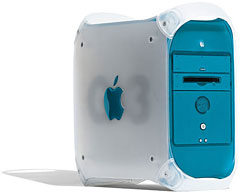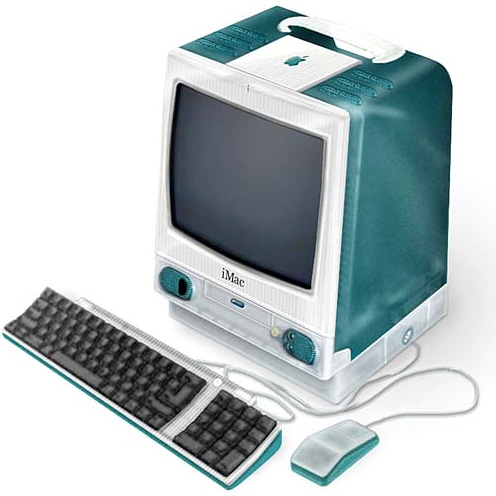1999: Last week, Evan Kleiman suggested that Apple produce a wider variety of models to meet the needs of more buyers (see More Macs). He even suggested that Apple open the door and allow cloning again.
In Pseudo Clones on osOpinion, Jonathan Gelling made a similar suggestion.
Apple’s Four Niches
Steve Jobs devised a four-quadrant strategy for Apple: consumer and professional markets with desktop and laptop computers. So we have the iMac, Power Mac, iBook, and PowerBook.
Four markets. Four computers. Four niches filled.
Too Few Niches
Steve Jobs is wrong if he thinks those are the only four markets out there, dead wrong.
Of course, I don’t think Jobs sees just four markets. Instead, he sees four primary markets where Apple needs to have a presence to survive.
Apple has hit the target in each market. The iMac was so perfectly designed and executed that it spent a year as the best selling computer. The Power Mac and PowerBook are almost everything a Mac power user could want. And the iBook promises to be a great blend of price, features, size, and performance.
But there are several markets Apple is missing.
Video Professionals
There is a small market of video professionals and other graphic specialists for whom the Power Mac G3 simply isn’t enough. They love the speed, accessible design, and most Power Mac expansion options – but they need more PCI slots.
 These people use Power Macs as power tools, not toys. They need to have more than three slots to plug in all their video input, digitizing, and other cards. But the Power Mac G3 leaves them with only three available expansion slots.
These people use Power Macs as power tools, not toys. They need to have more than three slots to plug in all their video input, digitizing, and other cards. But the Power Mac G3 leaves them with only three available expansion slots.
For this market, Apple should introduce a bigger Power Mac with at least two more expansion slots, more drive bays, and a more robust power supply to drive them all.
Because this market sees computers as tools, they are willing to pay the long dollar for the right hardware. Don’t use this as an excuse to gouge them, but this market has been complaining ever since the last six-slot Macs and clones were discontinued.
They’d rather stick with Apple, but they need a bit more expandability than Apple currently offers.
Budget Buyers
This is the home market and small business market. These are the low-end users who want a good computer for the money but would be hard pressed to justify spending more than $1,000 for any computer. (Of all the computers I’ve ever owned, only one has cost me over $1,000, so I count myself in this market.)
Today, 71% of the personal computer market is in sub-$1k computers.
As long as I’ve been writing editorials (see Dream Machines as one example), I’ve been suggesting that Apple produce one or more low cost Macs. This market would include both a small, inexpensive modular Mac and one with an integrated monitor.
If Apple could get the iMac below $1,000, it would certainly sell to this market. But I think the best hope is a “headless” iMac, a consumer Mac with no monitor.
There are several ways Apple could implement this. They could rearrange the insides of an iMac, putting them in a compact case, something around the size of the Macintosh IIsi or Performa 630.
Or they could build it around the Power Mac G3 motherboard, which is 10″ deep and 11.5″ wide. By eliminating three PCI slots, they could trim 2″ from the width (the G3 motherboard has no onboard video, so Apple would need to leave one PCI slot for a video card). Removing two DIMM slots would cut another 3/4″, bringing the width under 9″.
By putting the video card on a riser with a 90° bend, Apple could conceivably have a desktop only about 4″ tall with a footprint similar to the IIsi and Quadra 630.
Advantages of this approach include minor revisions to an existing motherboard design and ease of upgrade. As technology marches forward, the user would be able to easily replace the IDE hard drive, the G3 processor, and the video card.
A third approach would be a new motherboard design, which could include onboard video (3dfx please!) and possibly take up even less space than the 10″ x 9″ adapted Power Mac board I’ve suggested. If Apple does this, I have a few ideas:
- Make the plug-and-play USB and FireWire ports readily accessible by placing them on the front or on the side near the front. It’s a real pain reaching around the back (on the Power Mac G3) or inside a door (on the side of the iMac) to plug in devices. Make the ports as easy to reach as they are to use.
- Use the same ZIF design as the Power Mac G3 so the user can upgrade inexpensively when they need to.
- Include a single PCI expansion slot, because there may be something these users need that you didn’t build in. For instance, longtime Mac users might want a SCSI card for their old drives, an ADB port for an old keyboard or trackball, or the old Apple serial port for a sketch pad, ISDN modem, or printer. Wintel converts might want to add a DOS card. Give them that option.
However Apple does it, it should be able to sell the CPU with hard drive, CD-ROM, and 32 MB of memory for around $700-800 without compromising the quality we all expect from them.
 The iClassic
The iClassic
More details on this design later this week, based on feedback to last week’s column. However, it is interesting to note that the footprint of the early compact Macs was 9.6″ wide and 10.9″ deep – just big enough for the modified Power Mac motherboard proposed above.
The iClassic would be the sub-$1k computer proposed above with an internal monitor smaller than the iMac’s, probably something in the 10-12″ range.
Smaller, Smaller, Smaller
Perhaps the greatest disappointment of all was the size of the iBook. Based on the market, we can understand the price (although we all wish it was lower), the decision to include only 32 MB of memory, and the relatively small hard drive. But a lot of us were hoping for a more compact machine.
Apple has had some stellar “subcompact” portables: the PowerBook 100, the PowerBook Duo series, and the 2400c were all very capable lightweight machines. It’s a popular niche. And, done right, consumers will pay a premium for a smaller, lighter, fully capable laptop.
The current Lombard PowerBook G3 is a masterpiece. It reduces a desktop computer to a six pound portable package. The screen is to die for.
But the Wintel world has had four pound computers for years, going back to 1992, if not earlier. The 4.4 pound PowerBook 2400c was the closest Apple ever came – and those who have them, love them.
The smaller, lighter PowerBook should be just wide enough for a full-sized keyboard, just thick enough to hold the essentials, and just deep enough for a nice 12.1″ display (how about the same one used in the iBook?).
With the smaller screen, Apple should be able to produce a very nice thin-and-light PowerBook in the four pound range, undoubtedly sharing many components with the iBook.
Newton Meets Palm Meets Mac OS
One of the first things to get “Steved” was the Newton. It was a wholly remarkable computer, but it wasn’t a Mac and it wasn’t selling at adequate levels to keep the line alive.
Compared with the Mac, it used the wrong CPU and OS. It could transfer files easily, but it was pretty much incompatible with Mac applications.
Of course, the same can be said of the popular Palm line. (Those things keep showing up at work!) It doesn’t use a PowerPC or the Mac OS – yet Mac users are buying them in droves, as are Wintellians.
Apple has three options:
- Live and let live. Affirm the Palm. Be glad there’s another popular computing device that doesn’t run Windows. Work with Palm to improve integration with Macs.
- OEM the Palm. Have Palm build a special Mac version that comes bundled with all the software and hardware necessary for use with a Mac. Maybe make the Palm in PowerBook black and the fruity iMac colors. Regardless, make sure the Apple logo is very visible.
- Compete with the Palm. I don’t know how feasible this option is. Apple would build a PDA around a G3 processor, giving it a large enough screen to adequately run a version of the Mac OS, and integrating the handwriting recognition from the Newton (either using the Newton’s StrongARM processor or letting the G3 handle it). It would be a steep uphill battle against an established standard.
Frankly, I think Apple would be foolish to pursue this market with a Mac OS-based PDA. The little handhelds are far too different from desktop and laptop computers; it really would make very little sense to use a desktop operating system.
Instead, I’d like to see an Apple/Palm collaboration that markets the Palm in a Mac edition including the cables and software necessary to sync them.
Conclusion
There are a lot of niches the current Apple line misses. While the current line might meet the needs of 50-70% of the market, Apple could further improve market share by pursuing some of these markets.
Apple has already mastered cloning. Except for the Power Mac G3, it seems to have all the other models produced for it by other companies. It eliminates the variables of cloning, including the possibility of clones eating into Apple’s market. By making its own clones, Apple owns the entire Mac OS market.
And by producing additional models for additional niches, Apple increases the size of the Mac OS market.
I’d love to see Apple pick one niche from this list and make it its own. What do you think?
keywords: #macquadrants

